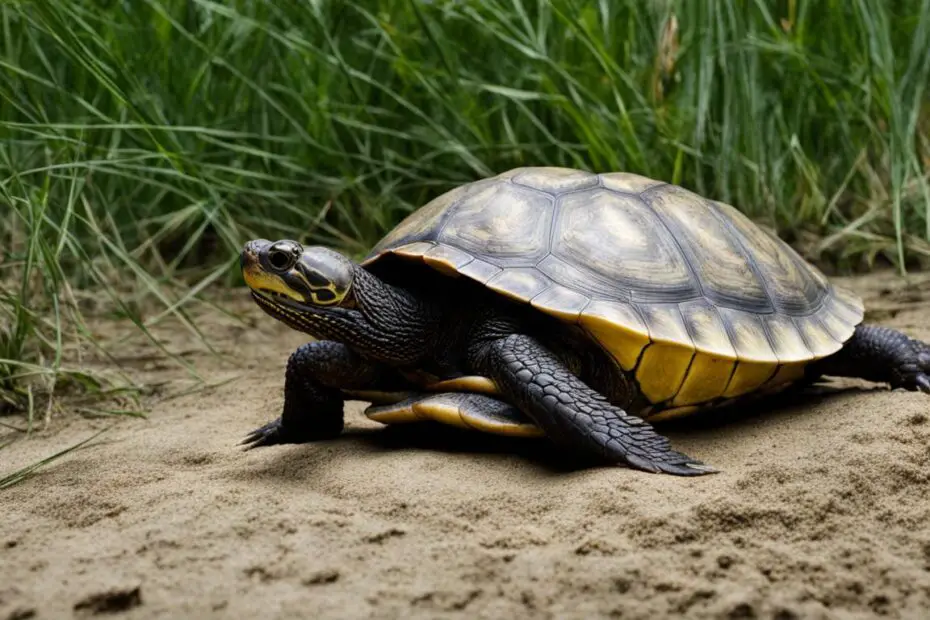Contrary to popular belief, a turtle’s shell is not detachable and is actually a part of its body. The shell is made of bone and is fused to the turtle’s spine. It consists of two parts – the carapace (top) and the plastron (bottom), with individual keratin scoots covering the carapace. The shell serves as the turtle’s armor and provides protection from dangers such as infection, bacteria, and predation. When the shell is damaged or removed, the turtle becomes vulnerable to various health issues, including systemic infections, organ damage, and weakened bones and shell growth.
Key Takeaways:
- The turtle’s shell is an inseparable part of its body, made of bone and connected to its spine.
- The shell provides crucial protection against infections, bacteria, and predators.
- Damage or removal of the shell can lead to systemic infections, organ damage, and weakened bones and shell growth.
- Proper care and protection of the turtle’s shell are essential for its overall health and well-being.
- Consulting a reptile veterinarian and providing a balanced diet, UV light exposure, and a clean environment can help ensure a healthy shell.
Understanding the Importance of the Turtle’s Shell
The turtle’s shell is a crucial part of its anatomy, serving as its ultimate defense mechanism. It is made of bone and is connected to the turtle’s spine, making it inseparable from the animal. The shell provides protection from external threats, such as injuries, infections, and predation. It also plays a role in the turtle’s overall health, as it allows for the absorption of UV light, essential for Vitamin D synthesis and bone and shell growth. Any damage or removal of the shell can have severe consequences for the turtle’s health and survival.
Imagine a shield that not only safeguards the turtle from harm but also contributes to its overall well-being. That’s exactly what the shell does. It acts as a barrier, shielding the turtle’s vital organs from potential injuries and providing a sturdy foundation for its skeletal structure. Like a suit of armor, the shell protects the turtle from predators, creating a secure space where it can retreat to when threatened.
But the shell’s role goes beyond physical protection. It is a dynamic structure that facilitates the turtle’s ability to thrive in its environment. By allowing the absorption of UV light, the shell enables the synthesis of Vitamin D, which is essential for healthy bone and shell growth. Vitamin D is crucial for calcium absorption, ensuring that the turtle’s bones and shell remain strong and properly developed.
“The turtle shell is an extraordinary adaptation that has evolved over millions of years. It provides not only physical protection but also contributes to the overall health and well-being of the turtle.”
Understanding the importance of the turtle’s shell highlights the significance of protecting it. Any damage to the shell, whether through trauma or human interference, can have detrimental effects on the turtle’s health and survival. It is crucial to prioritize shell protection and take measures to prevent injuries and maintain its integrity.
Next, let’s dive into the dangers of shell punctures and infections, exploring the potential risks that turtles face when their shell’s defense is compromised.

The Dangers of Shell Punctures and Infections
When a turtle’s shell is punctured, it creates a gateway for potential infections, posing serious threats to the turtle’s health. The shell, composed of living bone, acts as a protective barrier against external pathogens, such as bacteria, viruses, and fungi. Punctures in the shell can expose the internal organs housed within, making them vulnerable to life-threatening bacterial, viral, or fungal infections.
Immediate veterinary attention is crucial when treating shell punctures to prevent further complications. Veterinarians can provide the necessary care and medication to address existing infections and prevent the onset of additional complications. By taking swift action, the likelihood of a successful recovery increases significantly.
“The puncture in the shell not only compromises the physical integrity of the turtle, but it also opens doors to a myriad of potential infections. Swift and appropriate treatment is of utmost importance to ensure the turtle’s well-being.” – Dr. Samantha Johnson, Veterinarian
It is important to note that shell punctures require professional intervention as home remedies or delayed treatment can exacerbate the condition. Shell punctures can result from various causes, including predator attacks, traumatic incidents, or even accidental human interference. Regardless of the cause, any puncture in the shell should be taken seriously and addressed promptly.
Here is an illustration of the potential risks associated with shell punctures and infections:
| Shell Puncture Risks | Consequences |
|---|---|
| Bacterial Infections | Potential for systemic infection impacting the turtle’s overall health; requires prompt medical intervention. |
| Viral Infections | Viruses can infiltrate the turtle’s system, causing severe organ damage and compromising its overall well-being. |
| Fungal Infections | Fungi can infect the punctured areas, leading to tissue damage, impaired healing, and prolonged recovery periods. |

By painting turtle shells, we deprive them of this vital UV light absorption. Over time, this can result in weakened bones and shell deformities. The lack of proper UV light exposure can lead to nutritional deficiencies and metabolic bone diseases in turtles, causing long-term health complications.
The Consequences of Painted Shells:
- Weak and brittle bones
- Irregular shell growth patterns
- Development of shell deformities
- Increased vulnerability to injuries and infections
By avoiding the painting of turtle shells, we allow for the natural absorption of UV light and ensure the overall well-being of these amazing creatures. It is important to raise awareness about the adverse effects of painting turtle shells and promote responsible and ethical ways of appreciating their beauty.
Turtle Shell Care Tips for Healthy Growth and Regeneration
Proper turtle shell care is essential for ensuring healthy growth and regeneration. If a turtle’s shell is damaged, it has the potential to heal and regrow with the right medications and care. However, it is important to note that the process of shell regeneration can be a slow one, taking months to even years for complete restoration.
To promote the overall health of a turtle’s shell, several key factors should be considered:
- Provide a Balanced Diet: A well-rounded diet that includes a variety of nutrients is crucial for maintaining a healthy shell. Turtles should be offered a mix of commercial turtle pellets, fresh vegetables, and occasional protein sources, such as insects or fish. This ensures they receive the necessary vitamins and minerals needed for shell growth and repair.
- Sufficient UV Light Exposure: Turtles require exposure to UV light, specifically UVB rays, to synthesize Vitamin D and maintain proper shell health. Providing access to natural sunlight or using UVB lamps designed for reptiles is crucial. Make sure the turtle has access to both a basking area to absorb UVB light and a shaded area to prevent overheating.
- Maintain a Clean Environment: A clean and well-maintained living environment is vital for preventing shell issues. Regularly clean the turtle’s tank or enclosure to remove any debris, waste, or algae growth that can potentially damage the shell. Avoid using harsh chemicals or abrasive materials while cleaning, as they can strip away the protective layer of the shell.
Regular check-ups with a reptile veterinarian are highly recommended to monitor the health of a turtle’s shell. A veterinarian can identify and address any shell issues early on, providing appropriate treatment and guidance.

Common Shell-Related Health Issues in Turtles
Turtles, like any living creatures, can experience various shell-related health issues that require attention and care. Proper identification and timely treatment of these issues are crucial for the well-being and longevity of the turtles. Let’s explore some common shell-related health issues that turtles may encounter:
Shell Fractures
Shell fractures can occur due to trauma, such as car collisions or falls. These fractures can range from minor cracks to severe damage. Immediate veterinary attention is necessary for proper diagnosis and treatment. In some cases, shell fractures may require surgical intervention for proper healing and alignment.
Algae on Shell
Algae growth on the shell is a common occurrence in turtles, especially those kept in aquatic environments. While a minimal amount of algae is generally harmless, excessive growth can lead to potential health issues. Regular cleaning and tank maintenance can help prevent algae overgrowth and maintain a clean and healthy shell.
Shell Sloughing
Shell sloughing refers to the shedding of the outer layer of the shell. It is a natural process that allows the turtle’s shell to grow and regenerate. However, excessive or irregular shell sloughing can indicate underlying health issues. If you notice significant or continuous shell sloughing, it is advisable to consult a reptile veterinarian for a thorough examination and appropriate treatment.
Irregular Shell Growth
Irregular shell growth in turtles can manifest as softness, bumps, or asymmetry on the shell surface. It may indicate factors such as malnutrition or metabolic bone disease. Consulting with a reptile veterinarian can help identify the underlying cause and develop a suitable treatment plan to promote healthy shell growth and overall wellness.
It’s important to note that these are just a few examples of shell-related health issues in turtles. Each case may vary, and prompt consultation with a reptile veterinarian is recommended for accurate diagnosis and tailored treatment.
| Shell Issue | Description | Treatment |
|---|---|---|
| Shell Fractures | Cracks or breaks in the turtle’s shell due to trauma | Immediate veterinary attention; possible surgical intervention |
| Algae on Shell | Excessive algae growth on the turtle’s shell | Regular cleaning and tank maintenance |
| Shell Sloughing | Natural shedding of the outer layer of the shell | Normal process; consult a veterinarian if excessive or irregular |
| Irregular Shell Growth | Abnormalities in shell structure, such as softness, bumps, or asymmetry | Consult a reptile veterinarian for examination and treatment |
Proper shell maintenance and regular veterinary check-ups are crucial for preventing and addressing shell-related health issues in turtles. By providing a clean and suitable environment, ensuring a balanced diet, and seeking professional care, you can contribute to the well-being and longevity of these fascinating creatures.
Conclusion
In conclusion, the turtle’s shell is not just a mere piece of armor; it is an integral part of the turtle’s anatomy and plays a vital role in its health and well-being. It serves as a protective shield, guarding against infections, injuries, and predators. Therefore, ensuring turtle shell protection is crucial for their overall health.
Proper turtle health care involves taking preventive measures to avoid shell damage, such as punctures and fractures. Prompt veterinary attention should be sought for any shell-related issues to prevent infections and other complications. Additionally, providing turtles with a balanced diet, sufficient exposure to UV light, and regular check-ups can contribute to healthy shell growth and regeneration.
By understanding the significance of the turtle’s shell and implementing necessary precautions, we can ensure the turtle’s well-being and longevity. Let’s continue to prioritize turtle shell protection and healthcare, so these fascinating creatures can thrive and continue to enchant us with their unique beauty.
FAQ
Can a turtle live without its shell?
No, a turtle cannot survive without its shell. The shell is an essential part of its skeletal system and provides vital protection.
Is a turtle’s shell detachable?
No, a turtle’s shell is not detachable. It is fused to the turtle’s spine and is a permanent part of its body.
Why is a turtle’s shell important?
A turtle’s shell serves as its ultimate defense mechanism, protecting it from injuries, infections, and predation.
What happens when a turtle’s shell is removed or damaged?
When a turtle’s shell is removed or damaged, it becomes vulnerable to various health issues, including infections, organ damage, and weakened bones and shell growth.
Can a turtle’s shell grow back if it is damaged?
Yes, a turtle’s shell can often grow back with proper medications and care, although the regeneration process may take months to years.
Should I paint my turtle’s shell?
No, painting a turtle’s shell can have severe consequences for the animal’s health. It blocks the absorption of UV light, leading to weakened bones and shell deformities. It is important to avoid painting turtle shells.
How can I care for a turtle’s shell?
Proper turtle shell care includes providing a balanced diet, sufficient UV light exposure, a clean environment, and regular check-ups with a reptile veterinarian.
What are some common shell-related health issues in turtles?
Common shell-related health issues in turtles include shell fractures, algae growth on the shell, abnormal shell growth, and shedding of skin on the shell.

